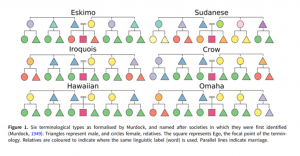There is huge potential for variation between kinship terminology (systems of words for relatives) cross-culturally. In fact, for a set of 16 relatives, there are 10,480,142,147 theoretically possible ways to categorise them. Given the potential for effectively unbridled variation in kinship terminology, observed diversity seems remarkably constrained, and has previously been categorised into six key types (see Fig. 1). Each type has been hypothesised to align with particular cultural norms of descent, marriage or residence patterns, and it was thought that these social systems acted as drivers of the variation and change of kinship terminology. However, since these conclusions were reached, there have been significant improvements in data and statistics. Will they still stand up when tested using more modern methods?
VariKin members Sam Passmore and Fiona Jordan’s 2020 publication No universals in the cultural evolution of kinship terminology put this to the test. They used phylogenetic comparative methods (PCMs) to explore the cultural evolutionary patterns of kinship terminology diversity, particularly testing so-called drivers of change such as marriage, residence and descent. This study marks the first cross-language-family phylogenetic analysis of the drivers of kinship terminology and investigates the Austronesian, Bantu and Uto-Aztecan language families (selected due to their large size and cultural data availability). In the study, they found no evidence for previously assumed universal drivers of evolution in kinship terminologies, because no presumed universal relationship linking kinship terminology and social structure was supported across all language families. This is not because one or two societies do not follow a trend: for most of the hypotheses tested, they could not conservatively even claim ‘statistical regularity’.
However, rather than assume that the lack of statistical relationship between kinship terminology types and social structure indicates no functional relationship, the authors suggest that the typology might misrepresent kinship terminological diversity by being too crude a characterisation. This raises the important question of how well existing typologies represent known diversity, and the results from this particular study – which was always an integral investigation of the VariKin Project – have helped to clear the ground for more detailed characterisations of kinship organisation in future. For example, as stated in the publication, the creation of the “Kinbank” database as part of the VariKin project will allow us to more realistically characterise types and patterns of change in kinterms without built-in assumptions of the influence from social structure.
